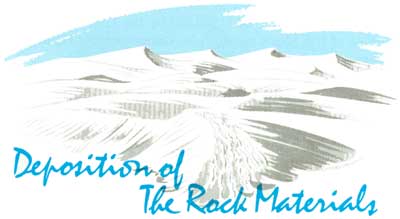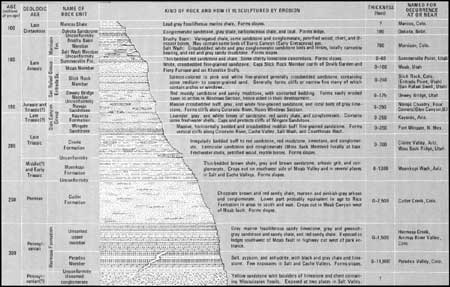
|
Geological Survey Bulletin 1393
The Geologic Story of Arches National Park |
DEPOSITION OF THE ROCK MATERIALS

THE VIVID and varied colors of the bare rocks and the fantastic buttes, spires, columns, alcoves, caves, arches, and other erosional forms of Arches National Park result from a fortuitous combination of geologic and climatic circumstances and events unequalled in most other parts of the world.
First among these events was the piling up, layer upon layer, of thousands of feet of sedimentary rocks under a wide variety of environments. Sedimentary rocks of the region are composed of clay, silt, sand, and gravel carried and deposited by moving water; silt and sand transported by wind; and some materials precipitated from water solutions, such as limestone (calcium carbonate), dolomite (calcium and magnesium carbonate), gypsum (calcium sulfate with some water), anhydrite (calcium sulfate alone), common salt (sodium chloride), potash minerals, such as potassium chloride, and a few other less common types. Some of the beds were laid down in shallow seas that once covered the area or in lagoons and estuaries near the sea. Other beds were deposited by streams in inland basins or plains, a few were deposited in lakes, and the constituents of deposits like the Navajo Sandstone, were carried in by the wind. The character and thickness of the exposed sedimentary rocks and the names and ages assigned to them by geologists are shown in the rock column (fig. 4) and in the cross section (fig. 8). The history of their deposition is summarized on pages 98-102. Figure 4 was compiled mainly from generalized sections given by A. A. Baker (1933), Dane (1935), McKnight (1940), and Wright, Shawe, and Lohman (1962), and, in part, from Hite and Lohman (1973).
Not exposed in the area but present far beneath the sedimentary cover and exposed in several places a few miles to the northeast are examples of the other two principal types of rocks— (1) igneous rocks, solidified from molten rock forced into or above preexisting rocks along cracks, joints, and faults, and (2) much older metamorphic rocks, formed from other preexisting rock types by great heat and pressure at extreme depths. Igneous rocks of Tertiary age (fig. 59) form the nearby La Sal Mountains. The particles comprising the sedimentary rocks in the area were derived by weathering and erosion of all three types of rocks in various source areas.
Arches National Park and nearby Canyonlands National Park are both in the heart of the Canyon Lands Section of the Plateau; therefore, it is only reasonable to wonder why the differences in their general character seemingly outweigh their similarities. First, let us consider the similarities. Both parks are underlain by dominantly red sedimentary rocks, both parks feature unusual erosional forms of sandstone, and both contain beautiful natural arches, although the arches in Canyonlands are restricted almost entirely to the southeastern part of The Needles section and are in much older rocks than those in Arches.
To be sure, differences in the rocks themselves play a part in the dissimilarity of the two parks, and these differences are of two types. First, there are lateral changes in the character of the strata, known to geologists as facies changes, brought about by differences in the environment, in the type of materials, and in the mode of deposition even within relatively short distances. Thus, during parts of the Permian Period while sand, later to be known as the Cedar Mesa and White Rim Sandstone Members of the Cutler Formation, was being deposited in the southern part of Canyonlands, red mud, silt, and sand of the Cutler were laid down farther north in Canyonlands (Lohman, 1974, fig. 9), and similar, though somewhat coarser, beds of the Cutler were laid down at Arches (fig. 4). Further comparisons of the rock columns in the two parks show that while limestones of the Rico Formation were being deposited in a shallow sea in the southern part of Canyonlands, additional red mud, silt, and sand of the Cutler were being laid down above sea level in areas to the northeast. The source of the coarser materials was the ancient Uncompahgre Highland, which stood above sea level from Late Pennsylvanian time to Late Triassic time (figs. 7, 59). Although wider and longer, it occupied about the same position as the present Uncompahgre Plateau between Grand Junction and Gateway, Colo. Streams eroded the hard igneous and metamorphic rocks from this ancient landmass and dumped the material into basins to the northeast and southwest. The basin to the southwest, now called the Paradox basin (after Paradox Valley, Colo.), at intervals contained shallow seas and lagoons, which I will discuss later.
Comparison of the rock columns for the two parks also reveals other differences. Both parks contain exposures of rocks as old as the Pennsylvanian Paradox Member of the Hermosa Formation. However, only in the Horseshoe Canyon Detached Unit of Canyonlands are rocks as young as the Jurassic Entrada Sandstone, whereas all the spectacular natural arches that make Arches famous were formed in the Entrada Sandstone, and Arches also contains several younger formations of Jurassic and Cretaceous age (fig. 4).
A commonly asked question is "Why are most of the rocks so red, particularly those in which the arches were formed?" This can be answered with one word—iron, the same pigment used in rouge and in paint for barns and boxcars. Various oxides of iron, some including water, produce not only brick red but also pink, salmon, brown, buff, yellow, and even green or bluish green. This does not imply that the rocks could be considered as sources of iron ore, for the merest trace, generally only 1 to 3 percent, is enough to produce even the darkest shades of red. The white or nearly white Navajo Sandstone and the Moab Member of the Entrada Sandstone contain little or no iron.
As pointed out by Stokes (1970, p. 3), microscopic examination of the colored grains of quartz or other minerals shows the pigment to be merely a thin coating on and between white or colorless particles. Sand or silt weathered from such rocks soon loses its color by the scouring action of wind or water, so that most of the sand dunes and sand bars are white or nearly so.
| <<< Previous | <<< Contents >>> | Next >>> |
bul/1393/sec5.htm
Last Updated: 8-Jan-2007
